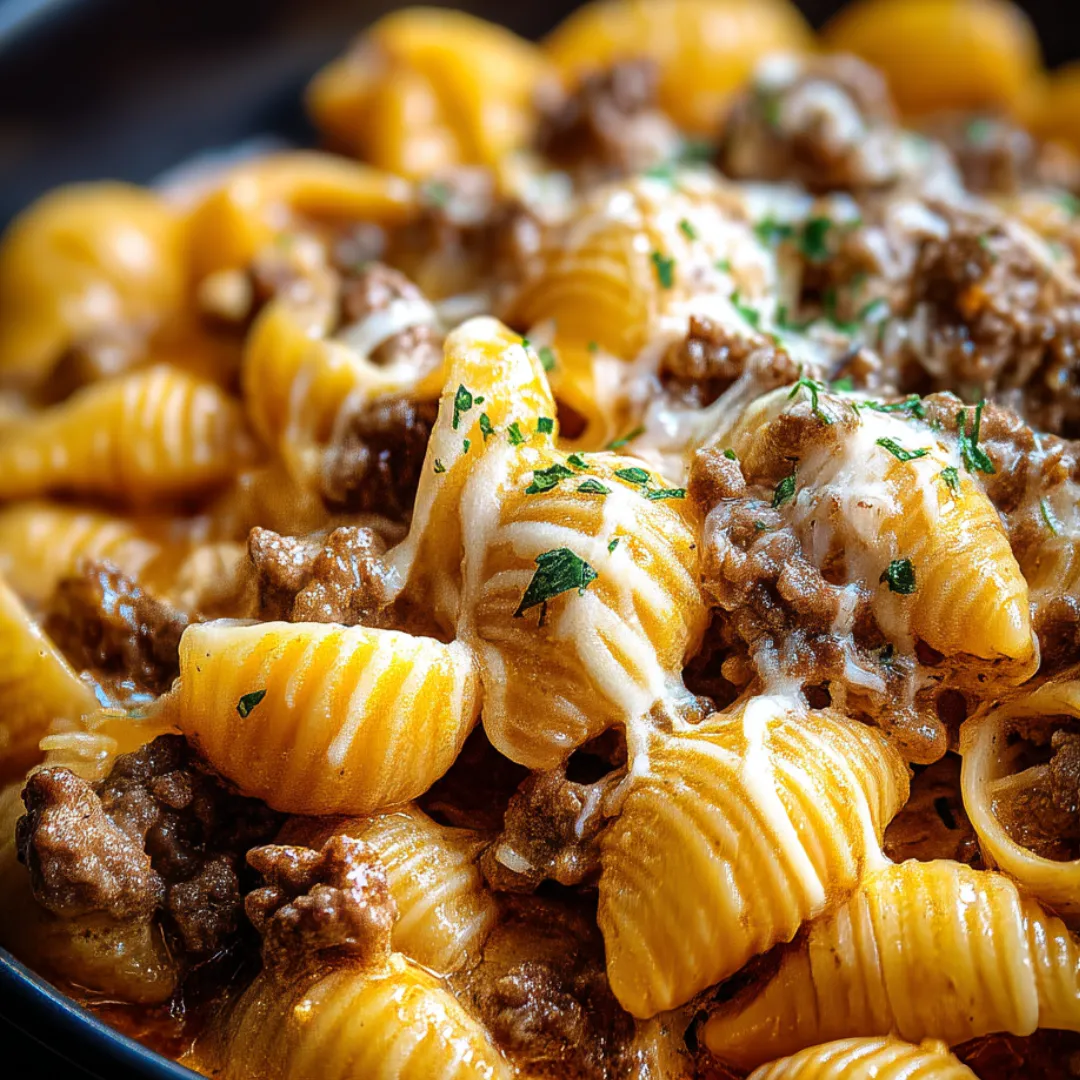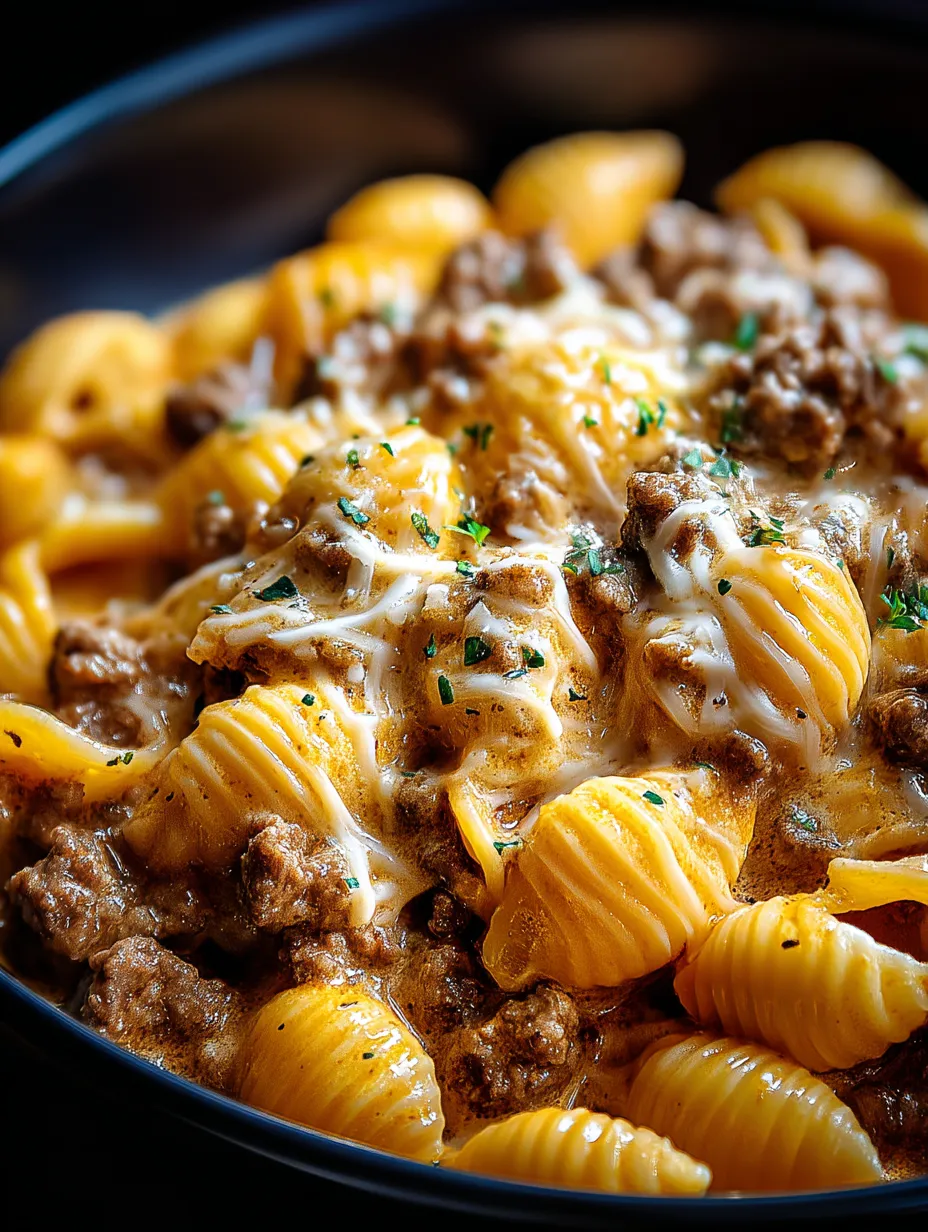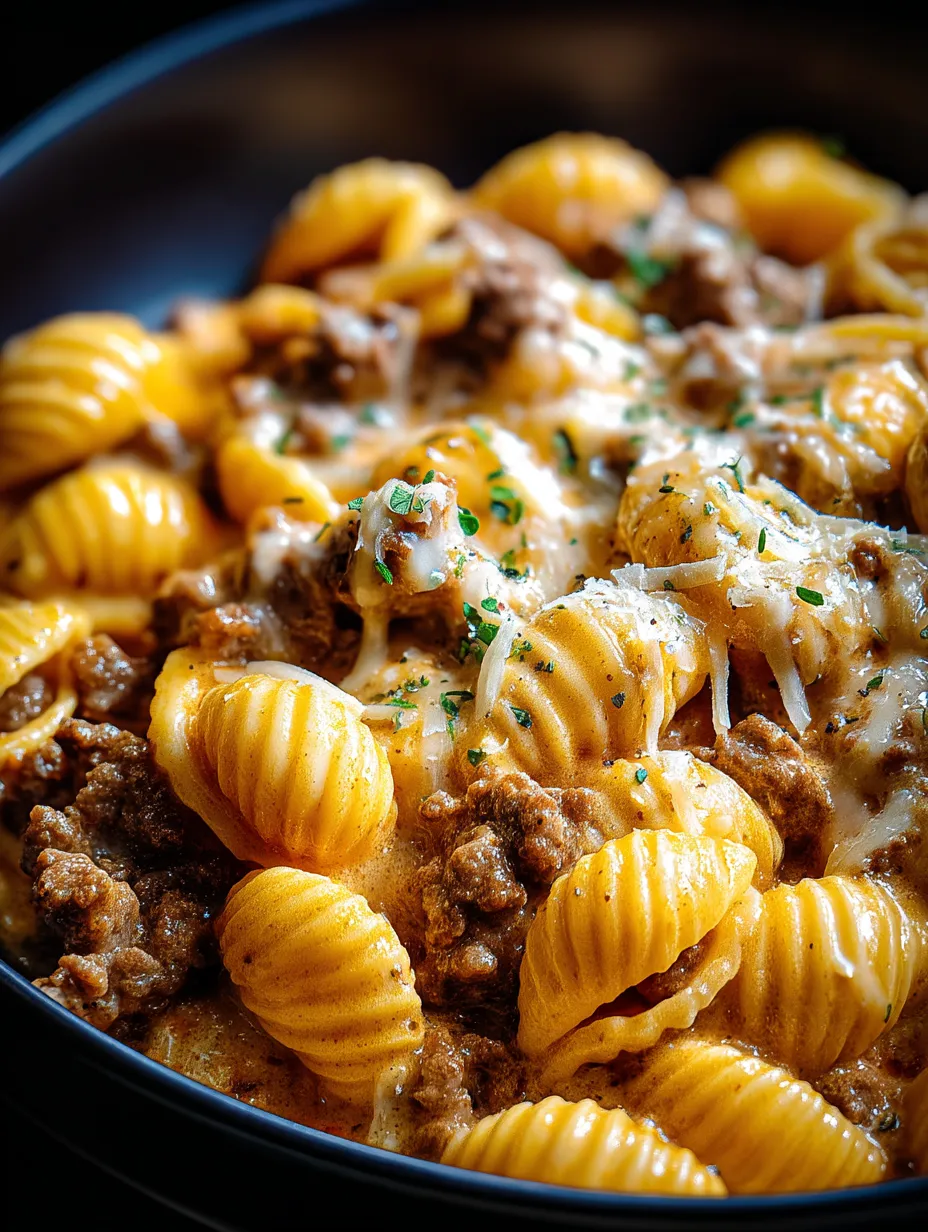 Pin it
Pin it
Tender pasta shells cradle a rich, velvety sauce infused with savory beef in this ultimate comfort food creation. The small shell-shaped pasta acts as perfect little pockets, capturing the creamy sauce in every bite while the seasoned ground beef provides satisfying heartiness. Each forkful delivers a harmonious blend of flavors – the mild tang of melted cheese, the subtle depth of herbs, and the savory richness of beef – all wrapped in a silky sauce that clings beautifully to the pasta. This one-pan wonder transforms basic ingredients into a meal that satisfies deep cravings for something substantial yet soothing.
I first created this recipe during a particularly hectic week when I needed something quick but craved the kind of comfort food that usually takes hours. My husband, typically indifferent to pasta dishes, took one bite and declared it "restaurant quality." When my notoriously picky niece cleaned her plate without a single complaint during a family dinner, I knew I had stumbled onto something special. Now it's my reliable solution for those evenings when I need to put something satisfying on the table but lack the energy for anything complex. The best part? The leftovers might taste even better the next day, making lunch something to look forward to rather than an afterthought.
Ingredients You'll Need
- Ground Beef: The savory foundation that gives this dish its hearty character. Choose 80/20 or 85/15 lean-to-fat ratio for the best flavor and texture. The slight marbling provides richness without excessive greasiness. Look for beef with bright color and no grey spots for maximum freshness. The beef not only adds protein but creates a meaty depth that transforms this from a simple pasta dish into a complete meal. If possible, select grass-fed beef for enhanced flavor and nutritional benefits, though conventional ground beef works perfectly well too.
- Medium Pasta Shells: These shaped pasta pieces are designed to capture and hold sauce within their curved forms. The medium size provides the perfect proportion of pasta to filling in each bite. When shopping, look for shells that are uniform in size and have a slightly rough texture, indicating quality pasta that will better grip the sauce. Cook them just until al dente, as they'll continue to soften slightly when combined with the hot sauce. The shells' unique shape creates little pockets that hold delicious pools of the creamy sauce, making each bite more satisfying than flat pasta shapes would.
- Heavy Cream: Contributes luxurious richness and silky texture to the sauce. The high fat content creates a stable emulsion that won't break or separate during cooking. For the best results, use cream that contains at least 36% milk fat (labeled as "heavy cream" or "heavy whipping cream"). The cream not only provides decadence but also helps mellow and bind together the flavors of the beef and seasonings. Its subtle sweetness balances the savory elements in the dish. While you can substitute half-and-half or even whole milk in a pinch, the sauce won't achieve the same velvety consistency.
- Sharp Cheddar Cheese: Adds tanginess and depth to the creamy sauce. Aged cheddar provides more complex flavor than mild varieties. Always buy blocks and grate it yourself rather than using pre-shredded cheese, which contains anti-caking agents that prevent smooth melting. The sharpness of the cheddar cuts through the richness of the cream, creating a balanced flavor profile. As it melts into the hot sauce, it creates strings of cheesy goodness that stretch between the shells. For the best flavor complexity, look for cheese aged at least 9 months, though any sharp cheddar will work well.
- Beef Broth: Forms the flavorful liquid base that helps create the sauce while adding savory depth. Choose low-sodium varieties to control the salt level yourself. The collagen in beef broth gives body to the sauce that water alone cannot provide. It also intensifies the beef flavor throughout the dish, creating a more cohesive flavor profile. If making your own, roast the bones first for deeper color and flavor. In a pinch, chicken broth can substitute but will create a lighter-flavored sauce that doesn't echo the beef as effectively.
- Aromatic Base: Onions and garlic create the essential flavor foundation. Look for firm onions with tight, dry skins and garlic with intact paper coverings. These aromatics provide depth that elevates the dish beyond simple pasta with meat sauce. When sautéed until translucent but not browned, onions release natural sweetness that balances the savory elements. The garlic should be minced finely to distribute its flavor evenly throughout the dish without creating harsh pockets of intensity. This aromatic base is what distinguishes a thoughtfully prepared dish from a basic one.
 Pin it
Pin it
Step-by-Step Instructions
- Step 1:
- Prepare your pasta with strategic timing – Begin by bringing a large pot of water to a rolling boil over high heat. Add a generous tablespoon of salt to the water—it should taste like seawater. This is your only opportunity to season the pasta itself. Add 8 ounces (about 2½ cups) of medium shell pasta to the boiling water and stir immediately to prevent sticking. Cook according to package directions until just barely al dente, typically 8-9 minutes, as the pasta will continue cooking slightly when added to the sauce later. Before draining, reserve ½ cup of the starchy pasta water—this liquid gold contains starches that help thicken and emulsify your sauce. Drain the pasta well but do not rinse it; the starchy surface helps the sauce adhere better. Toss the drained pasta with a light drizzle of olive oil to prevent sticking if you're not immediately adding it to the sauce. Timing is important—ideally, your pasta should finish cooking just as your sauce is ready to receive it.
- Step 2:
- Brown the beef for maximum flavor development – While the pasta water comes to a boil, place a large, heavy-bottomed skillet or Dutch oven over medium-high heat. Add 1 tablespoon of olive oil and allow it to heat until shimmering but not smoking. Add 1 pound of ground beef to the hot pan, breaking it into large chunks with a wooden spoon. Let it cook undisturbed for about 1 minute to develop a brown crust before breaking it into smaller pieces. Continue cooking, stirring occasionally and breaking up any large chunks, until the beef is well browned with no pink remaining, about 5-7 minutes. Proper browning creates the Maillard reaction, developing deep flavor compounds essential to the dish. If excessive fat renders from the beef, carefully drain off all but about 1 tablespoon, leaving enough to sauté the aromatics. The browned bits sticking to the bottom of the pan (fond) contain concentrated flavor that will eventually incorporate into your sauce.
- Step 3:
- Build your aromatic flavor base – Reduce the heat to medium and add 1 finely diced small onion to the browned beef. Cook for 3-4 minutes, stirring occasionally, until the onion becomes translucent and soft. Add 2 minced garlic cloves and cook for an additional 30-60 seconds until fragrant but not browned, as garlic can quickly become bitter when overcooked. This aromatic base creates the foundation for your sauce's flavor profile. Next, add 1 teaspoon dried oregano, 1 teaspoon dried basil, ½ teaspoon salt, and ¼ teaspoon black pepper, stirring to coat the beef and onion mixture with the herbs and spices. Cooking the dried herbs in the oil briefly releases their essential oils and intensifies their flavor. The mixture should be fragrant and well-seasoned, setting the stage for a flavorful sauce.
- Step 4:
- Create a rich, flavorful sauce base – Pour 1½ cups beef broth into the skillet, using a wooden spoon to scrape up any browned bits from the bottom of the pan. These caramelized bits dissolve into the liquid, enriching your sauce with concentrated beef flavor. Bring the mixture to a simmer and let it reduce by about one-third, approximately 3-4 minutes. This reduction concentrates the flavors and ensures the final sauce won't be too thin. Once reduced, lower the heat to medium-low and add 1 cup of heavy cream, stirring constantly as you pour it in. The cream should blend smoothly with the broth, creating a uniform color without separation. Allow this mixture to simmer gently (never boil) for about 2 minutes, stirring occasionally as it begins to thicken slightly. The sauce should coat the back of a spoon but still remain fluid enough to envelop the pasta shells.
- Step 5:
- Incorporate cheese for creaminess and flavor depth – With the heat still on medium-low, gradually add 1 cup of freshly shredded sharp cheddar cheese to the sauce, about ¼ cup at a time. Stir continuously between additions to ensure smooth melting and prevent clumping. If you have it available, add 2 tablespoons of cream cheese at this point, breaking it into small pieces for easier incorporation. The cream cheese adds an extra dimension of creaminess and helps stabilize the sauce. Once all cheese is melted and the sauce is smooth, taste it and adjust seasoning if necessary, remembering that the pasta will absorb some of the sauce's flavor. The sauce should have a silky, flowing consistency—if it's too thick, add a splash of the reserved pasta water; if too thin, simmer a bit longer to reduce.
- Step 6:
- Combine pasta and sauce with careful technique – Add the drained pasta shells directly to the sauce in the skillet. Using a wooden spoon or silicone spatula, gently fold the pasta into the sauce rather than stirring vigorously, which can break the delicate shells. Ensure every piece of pasta is well-coated with the creamy mixture. If the sauce seems too thick at this point, gradually add some of the reserved pasta water, a tablespoon at a time, until you reach your desired consistency. The starch in the pasta water helps maintain the sauce's creamy texture while thinning it slightly. Allow the combined pasta and sauce to simmer together for 1-2 minutes, which allows the pasta to absorb some of the sauce's flavor and further thicken the mixture. The shells should be tender but still hold their shape, with the sauce clinging to every ridge and crevice.
- Step 7:
- Finish with fresh touches for balance and brightness – Remove the skillet from heat and let it stand for 1-2 minutes. This brief rest allows the sauce to set slightly and the flavors to meld together. Just before serving, add fresh elements that contrast with the rich, cooked flavors. Sprinkle 2 tablespoons of finely chopped fresh parsley over the dish, which adds a pop of color and herbaceous brightness. For an extra flavor dimension, add a light grating of fresh Parmesan cheese on top, which introduces a nutty, salty note that complements the creamy sauce. A few grinds of fresh black pepper add visual interest and a subtle spicy note. These finishing touches elevate the dish from good to excellent, adding layers of flavor and visual appeal that make it feel more sophisticated despite its simple preparation.
- Step 8:
- Serve thoughtfully for the best experience – Transfer the creamy beef and shells to warmed plates or bowls—warm dishes help maintain the proper temperature and texture of the sauce. Portion sizes should be generous but not overwhelming, allowing the creamy sauce to pool slightly around the pasta. For family-style serving, transfer to a large, shallow serving bowl that showcases the saucy pasta. If desired, place extra grated cheese in a small bowl on the table for those who prefer an extra cheesy experience. Serve immediately while the sauce is at its optimal creamy consistency. This dish pairs wonderfully with a simple green side salad dressed with a vinaigrette that can cut through the richness of the pasta. A piece of garlic bread makes an excellent accompaniment for soaking up any remaining sauce on the plate—too delicious to waste.
I learned about the importance of pasta water the hard way during an early attempt at this recipe. Frustrated with a sauce that seemed too thick, I added plain tap water, which immediately diluted all the carefully built flavors and created a watery mess. Now I keep a coffee mug next to the stove as a visual reminder to save some pasta water before draining. My husband jokes that he can tell how my day has gone by how creamy I make this dish—the tougher the day, the more indulgent the sauce. My daughter, typically suspicious of "mixed foods," shocked us all by requesting this for her birthday dinner last year, proving that even selective eaters can be won over by the perfect balance of flavors and textures.
Perfect Pairings
This rich, creamy pasta dish pairs beautifully with sides that provide contrast in texture and freshness. A crisp green salad dressed with a bright vinaigrette cuts through the richness while adding nutritional balance. Try arugula with lemon vinaigrette for a peppery contrast that refreshes the palate between bites of creamy pasta.
Garlic bread or a crusty baguette makes an excellent accompaniment, perfect for sopping up extra sauce. The crisp exterior and soft interior of good bread provides textural contrast to the creamy pasta. For a lighter option that still provides that satisfying crunch, try roasted broccoli or green beans with a sprinkle of lemon zest.
For beverages, a medium-bodied red wine like Chianti or Merlot complements the richness of the dish without overpowering it. If you prefer white, try an unoaked Chardonnay or Pinot Grigio. For non-alcoholic options, sparkling water with a squeeze of lemon helps cleanse the palate between bites.
Clever Variations
The basic formula of this creamy beef and shells dish lends itself to countless variations. For a Southwestern twist, add a diced bell pepper with the onions and incorporate 1 teaspoon of cumin, ½ teaspoon chili powder, and a small can of diced green chiles. Top with chopped cilantro instead of parsley.
Create an Italian-inspired version by using Italian sausage instead of ground beef, adding a handful of sun-dried tomatoes, and substituting part of the cheddar with mozzarella and Parmesan. Finish with fresh basil instead of parsley.
For a lighter version, substitute ground turkey for the beef, use half-and-half instead of heavy cream, and incorporate 2 cups of fresh spinach in the final minute of cooking, allowing it to wilt into the sauce. The bright green color and slight texture creates visual appeal while adding nutrients.
 Pin it
Pin it
Clever Meal Prep Ideas
This dish reheats beautifully, making it ideal for meal planning. Prepare a full batch and portion into microwave-safe containers for quick lunches or dinners throughout the week. When reheating, add a splash of milk or cream to revive the sauce if it seems too thick.
For a make-ahead freezer meal, prepare the recipe through combining the pasta and sauce, but undercook the pasta slightly as it will soften further when reheated. Cool completely before transferring to freezer-safe containers. Freeze for up to 3 months and thaw overnight in the refrigerator before reheating gently on the stovetop with a splash of cream to refresh the sauce.
To stretch this recipe for larger gatherings, add a can of drained, diced tomatoes and an extra ½ cup of broth and cream. The tomatoes add flavor, color, and volume without significantly increasing the cost per serving.
This creamy beef and shells has rescued countless evenings in my home when time was short but we still craved something satisfying. There's something almost magical about the way the shells cup the sauce, creating perfect little bites of flavor. The beauty of this dish lies in its ability to feel indulgent while coming together with pantry staples and minimal effort. Even on the busiest weeknights, taking those few extra minutes to properly brown the beef and gradually build the sauce pays dividends in flavor that make it taste like you spent hours in the kitchen. Whether you're cooking for a family or preparing meals for yourself, this recipe delivers the kind of comfort that makes you feel taken care of—exactly what we all need at the end of a long day.
Frequently Asked Questions
- → Can I make this ahead of time?
- Yes, but the pasta may absorb more sauce as it sits. When reheating, add a splash of milk or broth to restore creaminess.
- → How do I store leftovers?
- Keep in an airtight container in the refrigerator for up to 3 days. The sauce might thicken, so add a little liquid when reheating.
- → Can I freeze this dish?
- Yes, but cream-based sauces can sometimes separate when frozen and thawed. For best results, freeze for up to 1 month and reheat gently.
- → What can I add to make this healthier?
- Try adding vegetables like spinach, peas, or diced bell peppers. You can also use whole wheat pasta and lean ground beef.
- → Can I make this with ground turkey instead?
- Absolutely! Ground turkey works great as a leaner alternative. You might want to add a bit more seasoning since turkey has a milder flavor than beef.
